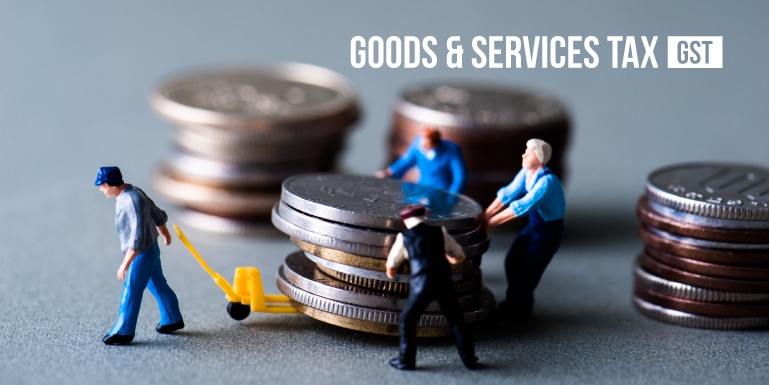

What is Goods and Services Tax (GST)?
Article 366 as amended by the 122nd Constitutional Amendment Bill, 2014, provides the meaning of GST as under:-(12A) “Goods and Services Tax means any tax on supply of goods or services or both except taxes on the supply of the alcoholic liquor for human consumption”.
In simple terms, Goods and Services Tax (GST) is an indirect tax (globally known as VAT) on value addition of goods and services i.e. at each point of sale and provision of service. The tax will be levied from the point of manufacture up to the point of final consumption with the availability of Input Tax Credit on each stage of transaction.
Why is Goods and Services Tax (GST) needed in India?
Introduction of Goods and Services Tax (GST) to replace the existing multiple tax structures of Central and State taxes is not only desirable but imperative in the emerging economic environment. In GST both the cascading effects of CENVAT and Service Tax will be removed with set-off, and a continuous chain of set-off from the original producer’s point and service provider’s point up to the retailer’s level would be established.
GST being a destination based consumption tax based on VAT principle, would also help in removing economic distortions caused by present complex tax structure and will help in development of a common national market. This is the essence of GST, and this is why GST is not simply VAT plus service tax but an improvement over the previous system of VAT and disjointed service tax.
Taxes subsumed under the Goods and Services Tax (GST):-
| Central Taxes | State Taxes and Levies |
| Central Excise Duty | VAT / Sales Tax |
| The Excise Duty levied under the Medicinal and Toiletries Preparation Act | Entertainment Tax (unless levied by local bodies) |
| Service Tax | Luxury Tax |
| Additional Custom Duty, commonly known as Countervailing Duty (CVD) | Taxes on lottery, betting and gambling |
| Special Additional Duty of Custom (SAD) | State Cesses and Surcharges in so far as they relate to supply of goods and services |
| Surcharges | Entry Tax |
| Cesses |
Note: - Basic Custom Duty (BCD) on Imports, Electricity Duty on Electricity and Stamp Duty on Real Estate will continue to exist.
Benefits of Goods and Services Tax (GST):-
- No Cascading of taxes
- No Double taxation
- No Entry tax, saving cost and time
- Reduced compliance cost
- Seamless flow of credit
- Few number of taxes
- Increase in Gross Domestic Product (GDP)
Components of Goods and Services Tax (GST):-
India is a federal country where both the Centre and the States have the powers to levy and collect taxes through appropriate legislation. Both the levels of Government have distinct responsibilities to perform according to the division of powers prescribed in the Constitution for which they need to raise resources.
Goods and Services Tax (GST) in India will be based on the concept of “Dual Model” which means that the proposed GST model will have two components:-
- Central Goods and Services Tax (CGST) – to be levied and collected by the central government
- State Goods and Services Tax (SGST) – to be levied and collected by the state government
A dual GST will, therefore, be in keeping with the Constitutional requirement of fiscal federalism.
Application of components of Goods and Services Tax (GST) on transactions:-
Intra State Transactions: - Both CGST and SGST will be levied.
Inter State Transactions: - Integrated Goods and Services Tax (IGST) model of taxation has been adopted for interstate transactions where Centre would levy IGST which would be CGST plus SGST.
- The Inter-State seller will pay IGST on value addition after adjusting available credit of IGST, CGST, and SGST on his purchases.
- The Exporting State will transfer to the Centre the credit of SGST used in payment of IGST.
- The Importing dealer will claim credit of IGST while discharging his output tax liability in his own State.
- The Centre will transfer to the importing State the credit of IGST used in payment of SGST.
- The relevant information will be submitted to the Central Agency which will act as a clearing house, i.e. verify the claims and inform the respective governments to transfer the funds.
Governing Laws for Goods and Services Tax (GST) Implementation:- There will be a central level statute for the levy of CGST and 30 statutes for the levy of SGST by all states.
IGST will govern the inter-state transactions; therefore a separate statute will be required for the same in the proposed GST regime.
Even if it will be implemented through multiple statutes, basic features of the law such as chargeability, definition of taxable person and table event, measures of levy, classification, etc. will be uniform across the states.
Governing principle for applicability of Goods and Services Tax (GST):-
Goods and Services Tax (GST) will be applicable on destination based principle. The destination principle is also known as consumption based principle which will be the reciprocal of the current origin based taxation regime.
Under the destination based structure, the power to levy tax on the inter-state taxable supply of goods and services will be on the State of consumption/destination. This is the main reason as to why exports are taxed in the country of consumption and not in the country of exportation.
Proposed Goods and Services Tax (GST) Rate Structure:-
Internationally, the tax rate in any new regime is derived based on Revenue Neutral Rate (RNR). In layman terms RNR is the rate that allows the Central and States to sustain the current revenues from tax collections.
In India based on various studies, though the rates are not finalized but, four broad classifications of rates are proposed in upcoming regime of GST.
- Merit Rate for essential goods
- Standard Rate for goods and services in general
- Special Rate for precious metals
- High / Demerit Rate
Exclusions/Exemptions under Goods and Services Tax (GST):-
It is likely that all the goods and services will be covered under GST but there will be certainly some exclusion.
If we talk about exclusions or exemptions at this point, the meaning of “Goods and Services Tax” itself excludes supply of the alcoholic liquor for human consumption.
Petroleum Products are under GST but will effectively come under it from the date notified by the GST council.
Further exclusions/exemptions will be finalized in the next meeting of GST council schedule to happen on 18th Oct 2016.
Exports, Imports and Special Economic Zone:-
As clarified in the First Discussion Paper (FDP), exports from India will be zero rated and the similar benefits will be given to Special Economic Zone (SEZs). However no such benefits will be allowed to the processing zone of the SEZs and sale from the SEZ to the Domestic Tariff Area (DTA).
On imports under GST regime apart from Basic Custom Duty, Integrated GST (IGST) will also be levied.
Treatment of Stock Transfer:-
At present, for inter-state branch transfer the assessee files a “Form F” which makes the transaction non-taxable. The inter-state branch transfer post GST scenario will be treated as if it is an inter-state supply of goods and thus, will attract Integrated Goods and Services Tax (IGST).
Availability of Input Tax Credit under Goods and Services Tax (GST):-
| Input Tax Credit | Output Liability | Set off Possible/Not Possible |
| CGST | CGST | Possible |
| CGST | SGST | Not Possible |
| SGST | SGST | Possible |
| SGST | CGST | Not Possible |
| IGST | IGST | Possible |
| IGST | CGST | Possible |
| IGST | SGST | Possible |
| CGST | IGST | Possible |
| SGST | IGST | Possible |
GST Compliance and Payroll Management: The Need for a Seamless Transition
With the implementation of Goods and Services Tax (GST), businesses across India have had to undergo a significant transformation in their taxation and financial management processes. One of the critical aspects of this transition is ensuring Global Payroll compliance while adapting to the new tax framework. Organizations that manage payroll across multiple jurisdictions must align their systems with GST regulations to maintain accuracy in tax deductions, reporting, and employee compensation structures.
Impact of GST on Payroll Services
GST has directly influenced various aspects of Payroll Services, including tax deductions on employee benefits, reimbursements, and professional services. Companies offering managed payroll solutions must ensure that their payroll processing adheres to GST compliance by correctly categorizing employee expenses, calculating tax credits, and integrating GST-related changes into payroll software.
Key considerations for businesses include:
- GST on Employee Benefits: Certain employee reimbursements, such as travel and accommodation, now fall under GST, requiring organizations to adjust their payroll processing accordingly.
- Impact on Contractor Payments: Independent contractors and consultants engaged through managed payroll services are subject to GST, necessitating automated compliance mechanisms to handle tax deductions seamlessly.
- Input Tax Credit (ITC) on Payroll Costs: Businesses may be eligible to claim ITC on payroll-related services, provided these costs directly contribute to revenue generation.
Technology-Driven Payroll Solutions for GST Compliance
To navigate the complexities of GST and payroll integration, enterprises are increasingly leveraging advanced Payroll Services platforms that offer real-time tax updates, automated compliance checks, and seamless integration with financial management systems. Cloud-based Global Payroll solutions, such as Ramco ERP on Cloud, provide end-to-end payroll automation, reducing manual effort and ensuring error-free tax compliance.
With GST streamlining tax structures across India, organizations must adopt a proactive approach to payroll compliance. Investing in robust managed payroll solutions that align with GST regulations can enhance financial accuracy, minimize compliance risks, and ensure uninterrupted business operations.
For businesses looking to simplify their GST and Payroll Services management, adopting a cloud-based ERP with integrated Global Payroll capabilities is the way forward.
So how prepared are you for GST?
With GST now in place, it is time for businesses to ensure they catch up to speed and seamlessly adapt as other taxes such as VAT, Excise, service tax and more will disappear giving way to one single Tax. This will help the taxation become simpler for the companies but with a cost of total rework on their existing taxation software and also employees working on it. This swift change in policy requires a technology which will ease the process and make the transition painless for the enterprises.
Ramco ERP on cloud, provides you with the adaptability required to address this change and also scalable enough to incorporate any further changes the policy makers are set to bring out in the future. Covering an entire spectrum of enterprise functions through a suite of products - Manufacturing, Financial Management, Supply Chain Management (SCM), Human Capital Management (HCM), Customer Relationship Management (CRM), Enterprise Asset Management (EAM), Project Management, Process Control, Analytics, Advanced Planning & Optimization, and Connectors, Ramco ERP on cloud is the #1 choice for futuristic businesses worldwide. Want to know how you can easily adapt and scale the changes in policy with technology? Write to us at contact@ramco.com today!
Frequently Asked Questions (FAQs)
Enterprise asset management (EAM) involves the management of mission critical assets of an organization throughout each asset's lifecycle. EAM is used to plan, optimize, execute, and track the needed maintenance activities with the associated priorities, skills, materials, tools, and information. The aim is to optimize the quality and utilization of assets throughout their lifecycle, increase productive uptime and reduce operational costs.
Enterprise asset management (EAM) involves the management of the maintenance of physical assets of an organization throughout each asset's lifecycle. EAM is used to plan, optimize, execute, and track the needed maintenance activities with the associated priorities, skills, materials, tools, and information.
The software helps in effective maintenance of assets through preventive, predictive, shutdown and breakdown maintenance strategies. The system also helps enterprises mitigate equipment risks by enhanced safety standards. The streamlined operations and improved asset performance helps organizations increase their investment effectiveness.
EAM is important because it helps organizations track, assess, manage and optimize asset quality and reliability. Asset intensive Organizations have hundreds, thousands, even millions of assets which needs to be maintained to maximize / optimize life of these assets to increase the return on investment.
The key features of effective EAM are:
- Work management.
- Maintenance Strategies (Preventive/ Predictive / Breakdown / Shutdown).
- Planning and scheduling.
- Supply chain management.
- Health and safety.
- Mobility.
- Analytics.
- Improved Asset Health at reduced cost through data driven maintenance Programs
- Complete visibilityon entire maintenance data across Equipment, across Models, across Branches to aid in analysis & decision making such as to Repair or Replace the Equipment
- Insightful analysis of Inspection Data to improve customer satisfaction
- Effective maintenance management enhanced by predictive maintenance and inbuilt analytics
- Increased reliability and safety, keeps complete track of all the inspections & calibration schedules
- Mobile Application enables users to execute work while “in the field” leading to minimized non-productive time and increased productivity and reduces duplication of work and human errors in recording information.
- Quick turnaround time through Actionable Notification & Alerts for every process in real time and accessible anytime and anywhere.
- Improved Regulatory Part of asset management involves the implementation of better O&M practices, which can significantly improve compliance.
Asset Intensive companies under the following Industries :
- Ports
- Cement and Mining
- Utilities
- Fleet Maintenance
- Equipment Rental
- Other Manufacturing
- Real Estate & Infrastructure
- Power Generation
Contact us for a meeting and schedule a demo
This differs on case to case basis, based on the type of installation and unique industry specific requirements. Contact us for a meeting and schedule a demo.
This differs on case to case basis, based on the type of installation and unique industry specific requirements. Contact us for a meeting and schedule a demo.
Stay Connected, follow us on LinkedIn / Twitter to know more about EAM Software latest trends.


